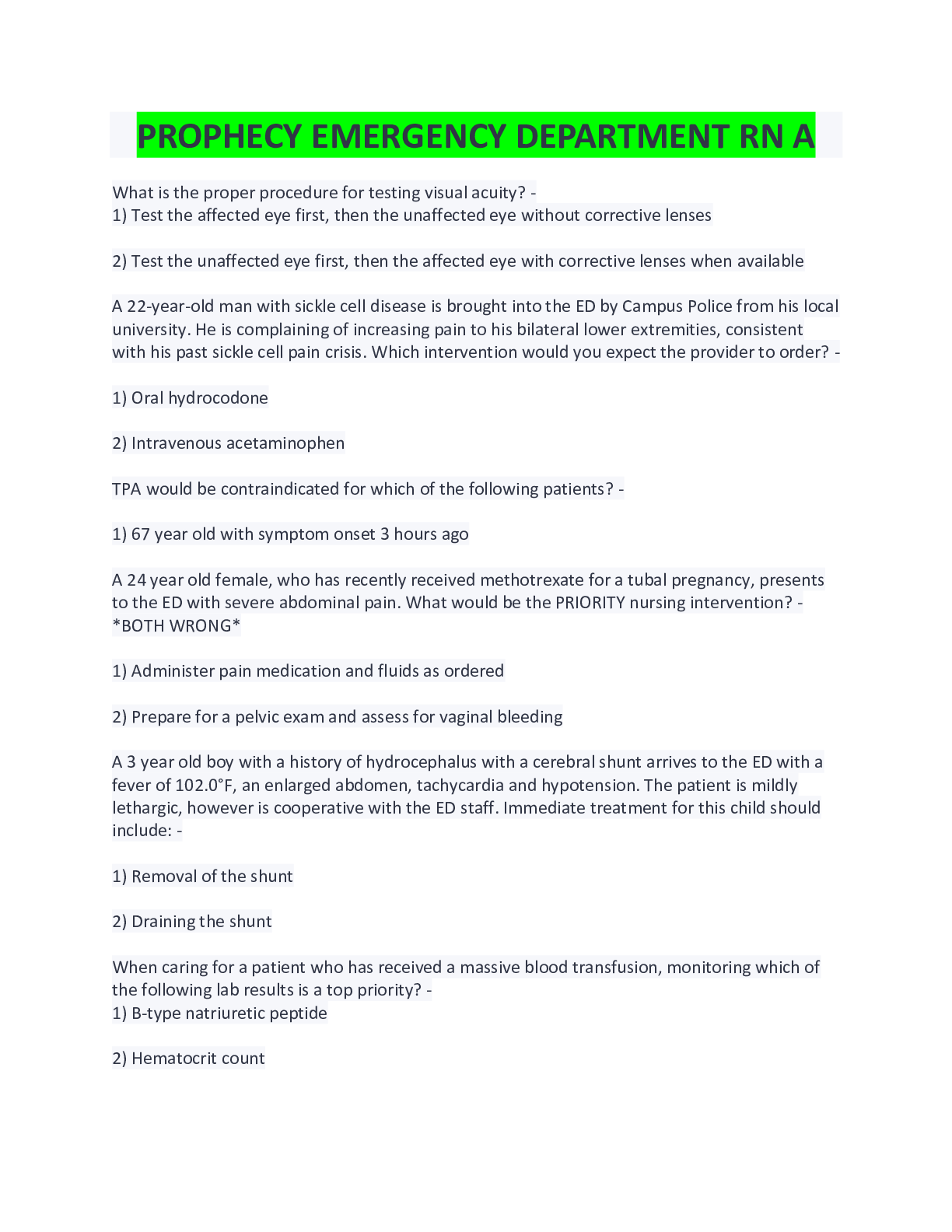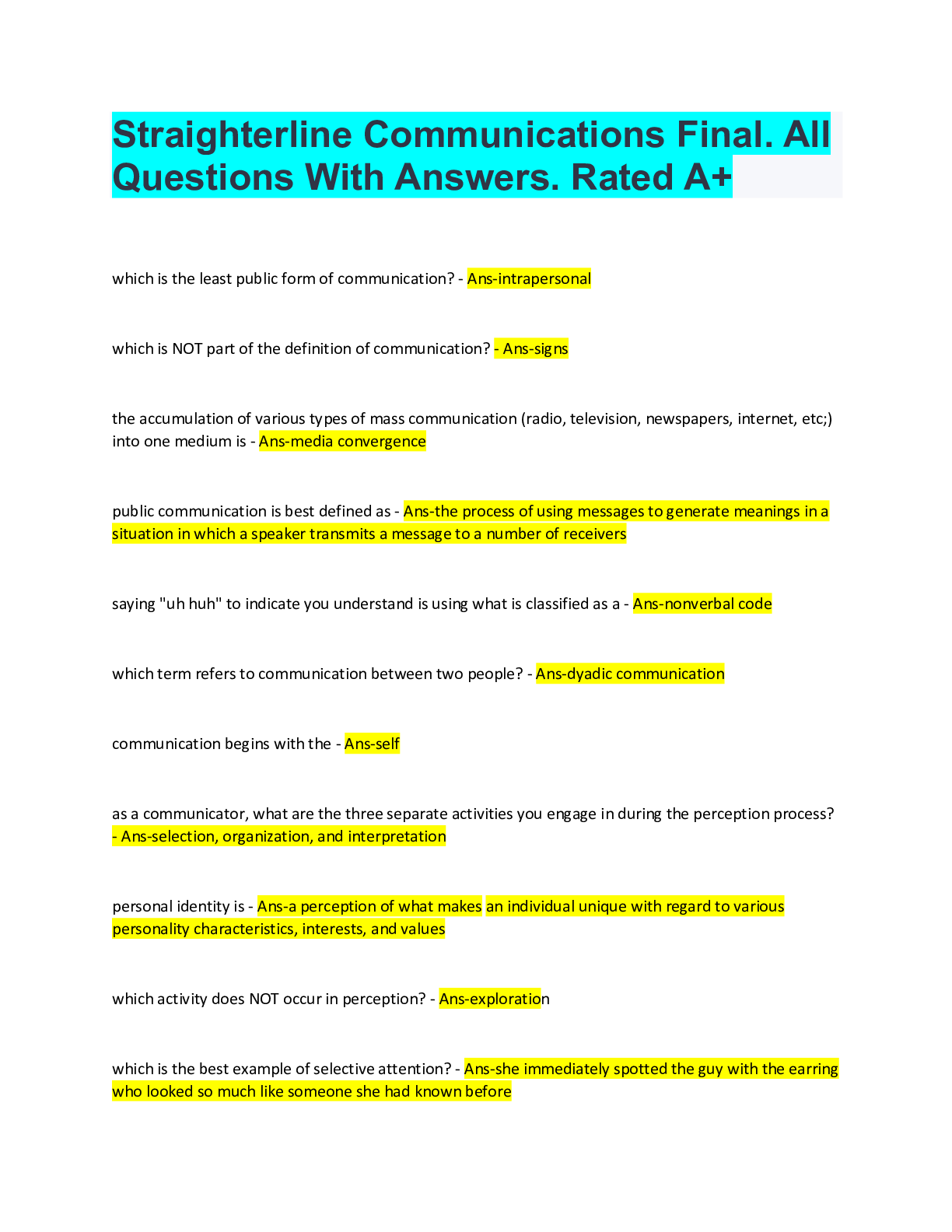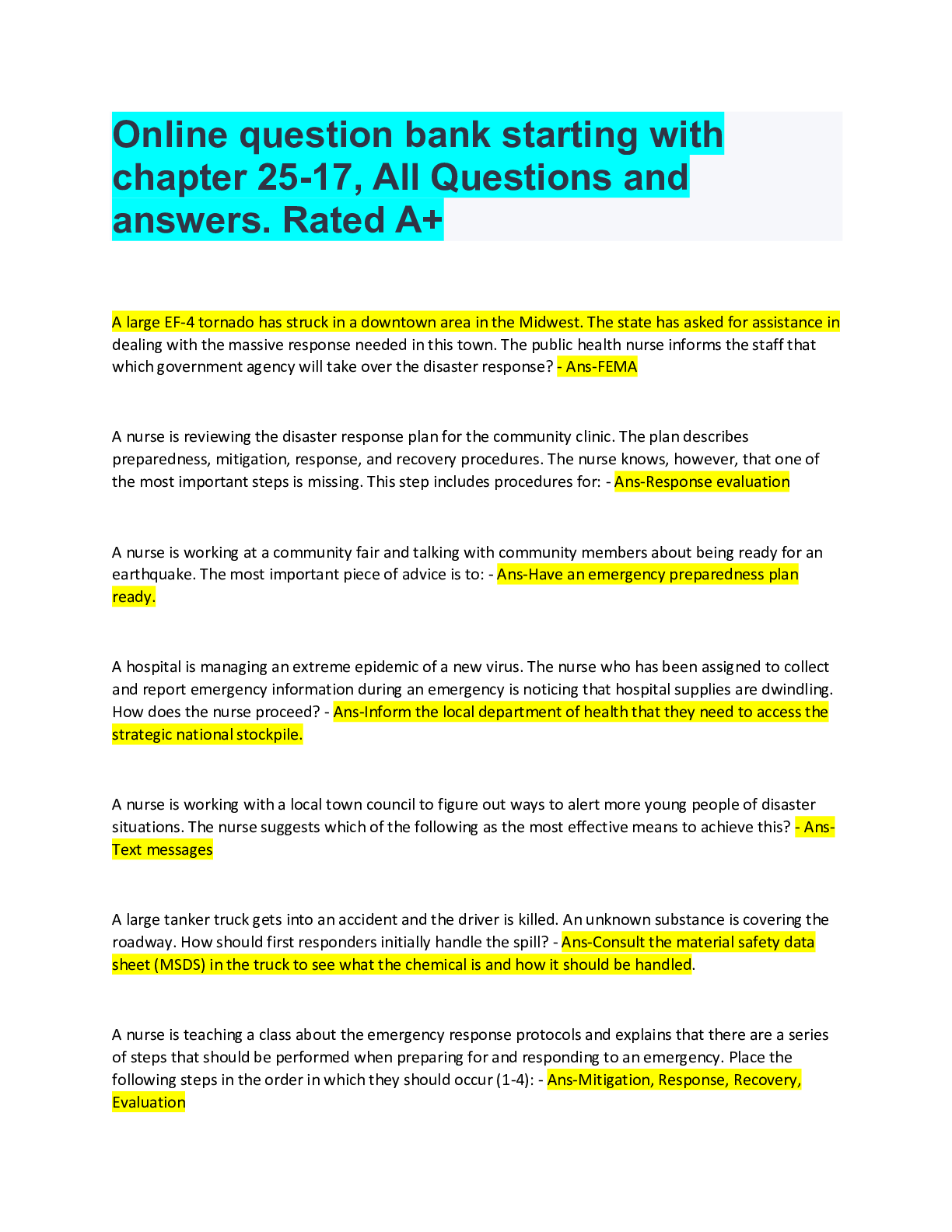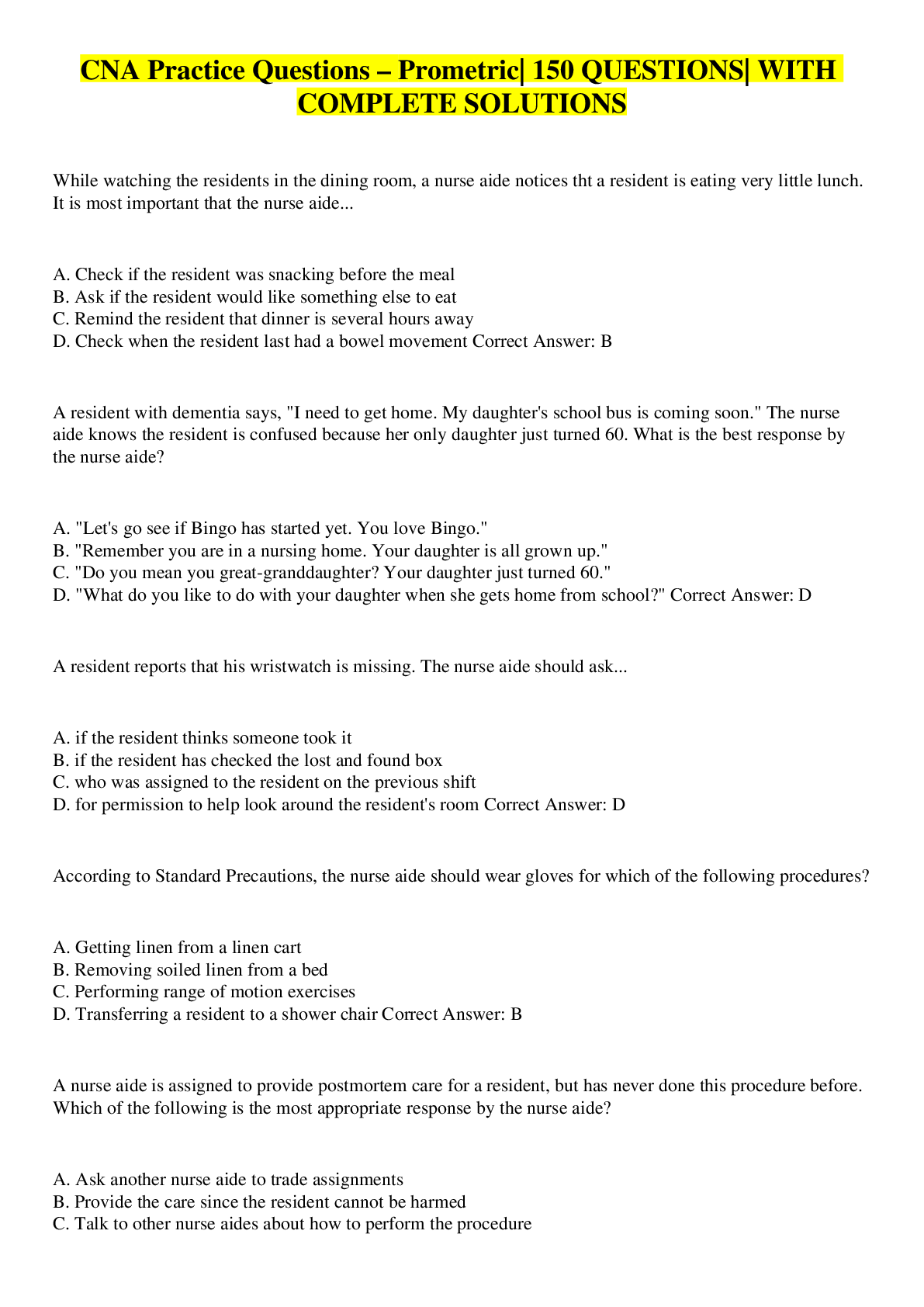Social Sciences > QUESTIONS & ANSWERS > Fisdap Airway Management Questions and Answers Rated A+ (All)
Fisdap Airway Management Questions and Answers Rated A+
Document Content and Description Below
Fisdap Airway Management Questions and Answers Rated A+ Potential effects of orotracheal intubation. ✔✔Secure airway, Protection against aspiration. Bleeding, hypoxia laryngeal swelling, laryng... ospasms, vocal cord, mucosal necrosis, barotrauma. Potential effects of moving an intubated patient. ✔✔With a firmly secured tube the tip of the ET tube can move as much as 2 inches with head flexion and extension; with hyperflexion the tube can be pulled from the trachea completely. Hyperextension can cause the ET tube to be pushed further into the trachea. Consider C-collar to keep the head in neutral position. When to exubate a patient? ✔✔Patients are rarely extubated in the prehospital setting. The only reason to consider extubation is if the patient is extremely intolerant of it or the ET tube is placed incorrectly. (Extremely combative, gagging or retching). It is typically safer to sedate the patient rather than extubate. Before performing field extubation, you should contact medical control or follow local protocols. Potential effects of overinflation of the distal cuff. ✔✔Overinflation of the distal cuff may cause tissue necrosis of the tracheal wall. Indications for airway suctioning. ✔✔When the patient's mouth or throat becomes filled with vomit, blood or secretions. Audible gurgling. Gold standard for successful intubation. ✔✔The gold standard is endotracheal intubation; Gold standard for evidence of successful intubation is in-line capnography. Indications for direct laryngoscopy and magill forceps. ✔✔If you are unable relieve a severe airway obstruction in an unresponsive patient with basic techniques. Have Magill forceps available should you need to guide the ET tube between the vocal cords or if you encounter a foreign body obstruction during laryngoscopy. Potential complications of endotracheal intubation. ✔✔Bleeding, hypoxia, laryngeal swelling, laryngospasm, vocal cord damage, mucosal necrosis, and barotrauma. Anatomical place of a Miller blade. ✔✔The straight laryngoscope blade (Miller) is designed so that its tip will extend beneath the epiglottis and directly lift it up. Anatomical placement of a Macintosh blade. ✔✔Curve of blade conforms to tongue and pharynx. The tip of the blade is placed in the vallecula. Indications for nasotracheal intubation. ✔✔Nasotracheal intubation is indicated for patients who are breathing spontaneously but require definitive airway management to prevent further deterioration of their condition. Responsive patients and patients with an altered mental status and an intact gag reflex who are in respiratory failure because of conditions such as COPD, asthma, or pulmonary edema. Volume of the distal cuff of a endotracheal tube. ✔✔5-10 mL Correct tube placement confirmation. ✔✔1. Visualizing the the ET tube passing between the vocal cords. 2. Equal and bilateral lung sounds. 3. If the ET tube has been placed properly then it should be easy to compress the bag-mask device, and you should see corresponding chest expansion. 4. Continuous waveform capnography, ETC02 detector or an esophageal detector device. Treatment of FBAO. ✔✔1.If a patient with a suspected airway obstruction is responsive ask if they are choking. If they can speak encourage them to cough. If they can't speak, begin treatment immediately. 2. Open the airway and attempt ventilation. If unable to ventilate, reposition airway and reattempt ventilation. 3. If you find large pieces of vomitus, mucus, loose dentures or blood clots in the airway, then sweep them forward out of the mouth with your gloved index finger. 4. No blind finger sweeps 5. The abdominal thrust maneuver is the most effective method. 6. You should perform the Heimlich maneuver on any responsive child or adult with any severe airway obstruction until the obstructing object is resolved or until the patient becomes unresponsive. 7. For pregnant and obese patients, perform chest thrusts instead. 8. If patient becomes unresponsive, begin CPR. After compressions, check airway and remove object only if you can see it. If not, resume chest compressions. 9. If you are unable to relieve a severe airway obstruction in an unresponsive patient with the basic techniques, then proceed with direct laryngoscopy for the removal. 10. Insert the blade in the mouth, if you see the foreign body, carefully remove it from the upper airway with the Magill forceps. Airway management for facial trauma. ✔✔1. Control bleeding with direct pressure, and suction the airway as needed. 2. If you can not control the source of the oropharyngeal bleeding, then perform continuous suction and intubate the trachea. 3. Use the jaw-thrust maneuver when opening the airway. 4. If you are unable to effectively ventilate or orally intubate a patient with severe facial injuries, then perform a cricothyrotomy. Time limit to intubate. ✔✔30 seconds. Use of a nasogastric tube in an intubated patient. ✔✔A nasogastric tube is an effective tool for removing air and liquid from the stomach, reducing the risk of regurgitation and aspiration. DOPE ✔✔Displacement of breathing tube Obstruction Pneumothorax Equipment Failure Indications for tube suctioning. ✔✔Tracheobronchial suctioning involves placing suction catheter into the ET tube to remove pulmonary secretions. Preoxygenate prior to suctioning. Only perform if secretions are so massive that they interfere with ventilation. Diagnostic tools for assessing respiration and perfusion. ✔✔Pulse oximetry, Peak expiratory flow meter, Arterial blood gas analysis, ETCO2, Colorimetric CO2 detector, Capnometer, Capnographer. Basic management techniques for airway. ✔✔Open the airway Clear the airway Assess breathing Provide appropriate interventions; airway adjuncts, ventilatory assistance, oxygenation. Airway management for opioid overdose. ✔✔Establish and maintain a patent airway. Provide adequate ventilation. Place an airway adjunct; OPA, NPA, and ventilate with a BVM at 15 LPM. If unable to open and maintain airway, preoxygenate and then intubate. Administer naloxone; 0.4 to 2 mg, IV, IM. Intranasal; 1 mL per nostril. Follow local protocols or contact medical control if you feel patient needs a higher dose of naloxone. Hyperventilation syndrome ✔✔Hyperventilation occurs when people breathe in excess of metabolic need by increasing the rate or depth of respiration, or both, expelling more carbon dioxide than normal. The result is alkalosis. As the patient's carbon dioxide dips, the pH level rises When this cycle is triggered by emotional stress or a panic attack, this is called hypoventilation syndrome. In acute hypoventilation syndrome, patients usually feel as though they can't breathe at all. Tx of the Asthma patient. ✔✔Bronchospasm: Treat with bronchodilator Bronchial edema: Treat with corticosteroids. Increased mucus production: Treat with hydration, mucolytics, and expectorants. Shark finning ✔✔A shark fin capnographic waveform indicates bronchospasms. Signifies difficulty with exhalation and incomplete alveolar emptying. Indications for positive pressure ventilation. ✔✔Patients who are breathing inadequately; too fast or too slow with reduced tidal volume (shallow breathing). Irregular breathing pattern Signs of altered mental status and inadequate minute volume. Accessory muscle use and labored breathing. Complications of too fast or forceful BVM ventilations. ✔✔Gastric distension (and associated risks of vomiting and aspiration), and decreased venous return to the heart (preload) due to increased intrathoracic pressure. Corrective action for low or high ETCO2. ✔✔Low: Due to hyperventilation, decrease ventilatory rate. High: Due to hypoventilation, increase ventilatory rate. Surfactant. ✔✔A liquid protein substance that coats the alveoli in the lungs, decreases alveolar surface tension, and keeps the alveoli expanded; a low level in a premature infant contributes to respiratory distress syndrome. external respiration ✔✔External respiration pulmonary respiration) is the process of exchanging oxygen and carbon dioxide between the alveoli and blood in the pulmonary capillaries. Respiratory acidosis ✔✔Respiratory acidosis is always related to hypoventilation. Decreased lung tidal volume reduces the amount of CO2 that is exhaled, causing hypercapnia (increased CO2) respiratory alkalosis ✔✔Respiratory alkalosis is associated with conditions that result in hyperventilation. Increased respiratory rate decreases the amount of circulating carbon dioxide in the body. Hyperventilation accompanied by carpopedal spasm is a classic sign of respiratory alkalosis. Indications for albuterol nebulizer. ✔✔Bronchospasms ( COPD, Asthma, Burns, Pneumonia, Anaphylaxis), Hypokalemia. Pulmonary Embolism S/S; Tx. ✔✔Sudden dyspnea and cyanosis, sharp pain in the chest. Cyanosis that doesn't resolve with oxygen therapy, blood clot in legs. Tx: Anticoagulants S/S of CHF (left sided) ✔✔Failure of the left ventricle causes an accumulation of fluid in the pulmonary system (pulmonary edema) Pulmonary edema (fluid in lungs) Dyspnea Orthopnea (inability to breathe while lying flat) Abnormal lung sounds (crackles, rales) Hypoxemia ALOC S/S of hyperventilation syndrome ✔✔Rapid respiratory rate, carpopedal spasms. Tx for benzo overdose ✔✔Airway maintenance, cardiorespiratory monitoring and support. IV fluids. Flumazenil, Activated charcoal. Physiological effects of respiratory failure ✔✔Acute respiratory failure occurs when fluid builds up in the air sacs in your lungs. When that happens, your lungs can't release oxygen into your blood. In turn, your organs can't get enough oxygen-rich blood to function. You can also develop acute respiratory failure if your lungs can't remove carbon dioxide from your blood. Respiratory failure happens when the capillaries, or tiny blood vessels, surrounding your air sacs can't properly exchange carbon dioxide for oxygen. The condition can be acute or chronic. s/s of aspiration ✔✔Gurgling, coughing, feeling that something is stuck in throat, wheezing, trouble breathing. Indications for needle cricothyrotomy ✔✔The inability to ventilate the patient by other, less invasive techniques; Massive maxilofacial trauma; inability to open the patient's mouth; uncontrolled oropharyngeal bleeding. S/S of ammonia inhalation ✔✔Swelling and irritation of the upper airway. If the substance gets in the patient's eyes, they eyes will burn, feel inflamed and irritated. S/S of epiglottitis ✔✔Severe, rapidly progressive inflammation of the epiglottis, may be fatal due to sudden airway obstruction. Sore throat, fever, drooling, hoarseness, purposeful hyper extension of the neck. Laryngotracheitis (Croup) ✔✔Condition characterized by stridor, hoarseness and a barking cough that most commonly occurs in infants and children S/S of emphysema ✔✔Barrel chest, tachypneic, pursed lip breathing, increased I/E ratio, abdominal muscle use, JVD. S/S of pneumonia ✔✔Weakness, productive cough, fever, sometimes chest pain that worsens with coughing, shaking chills, crackles in the lungs, tactile fremitus, sputum production. Respiratory drive in a COPD patient. ✔✔Hypoxic Drive: state in which a person's stimulus to breathe comes from a decrease in PaO2 rather than from the normal stimulus, an increase in PaO2. S/S of spontaneous pneumothorax ✔✔Tachycardia, low SPO2, cyanosis, wheezing, pain/swelling in 1 or both legs, decreased lung sounds in injured lung, shortness of breath. S/S of bronchoconstriction and treatment ✔✔Coughing, wheezing, chest pain or tightness. Tx: Bronchodilator; albuterol, short acting beta agonists, inhaled corticosteroids. S/S of polycythemia ✔✔Caused by reduced blood flow - Plethora; Overproduction of red blood cells. Ruddy complexion; Fatigue; Dizziness; Headache. S&S of acute respiratory distress syndrome ✔✔Caused by diffuse damage of the alveoli, perhaps as a result of shock, aspiration, pulmonary edema, barotrauma or a hypoxic event. S/S labored and rapid breathing, general weakness, low BP. S/S of chronic bronchitis ✔✔Excessive mucus production, chronic/recurrent productive cough, wheezing. Commonly a heavy smoker. Overweight, blue complexion. Hypercapnia, hypoxemia. S/S of cystic fibrosis ✔✔A genetic disorder of the endocrine system that makes it difficult for chloride to move through cells. Primarily targets respiratory and digestive system. S/S: Increased production of mucus in the lungs and digestive tract, recurrent resp infections. Pediatric: Tachypnea, chest pain and crackles, accessory muscle use, nasal flaring. S/S and tx of airway burns ✔✔Visible airway swelling, stridor, supraglottic trauma, burns to head/neck/face. Tx: airway management via BVM, followed by intubation if necessary. S/S of reactive airway disease (Asthma) ✔✔Bronchospasm; Tx: Bronchodilator Airway/Bronchial edema; Tx: Corticosteroids Increased mucus production; Tx: Water and expectorants. Assessment and management of tracheostomy tubes. ✔✔Tube placed within the stoma. Can oxygenate through the tube via attachment or placing and oxygen mask over the tube. Pt's may experience sudden dyspnea due to thick secretions within the tube. Suction the tube as you would a stoma. If the tube becomes dislodged, attempt to replace it. If you are unable to, move forward with an ET tube and insert it through the stoma. 0.5 to 0.75 inches in depth. Auscultate lungs to confirm placement. Assessment and management of stoma. ✔✔Monitor stoma and make sure it doesn't become occluded with secretions. Suctioning may be required.(10 seconds at a time). Inject 3 mL saline and suction with catheter. Stoma ventilation: Infant or child size mask over stoma. Ensure adequate seal. Seal mouth and nose upon inhalation and release at end of each ventilation. (Exhalation through upper airway) Requires two rescuers. S/S of subcutaneous emphysema ✔✔Subcutaneous emphysema occurs when air infiltrates the subcutaneous (fatty) layers of the skin is characterized by a "crackling sensation" when palpated. Can be a result of cricothyrotomy tube misplacement. right mainstem intubation ✔✔Endotracheal tube enters right main stem bronchus. Unequal breath sounds; uneven chest rise and fall. What are the 3 main items that an end-tidal CO2 monitor measures? ✔✔Metabolism, perfusion and ventilation. [Show More]
Last updated: 10 months ago
Preview 1 out of 16 pages

Reviews( 0 )
Document information
Connected school, study & course
About the document
Uploaded On
Jul 16, 2023
Number of pages
16
Written in
Additional information
This document has been written for:
Uploaded
Jul 16, 2023
Downloads
0
Views
80

.png)
.png)
.png)
.png)
.png)
.png)
.png)
.png)
.png)
.png)
.png)

.png)

.png)
.png)



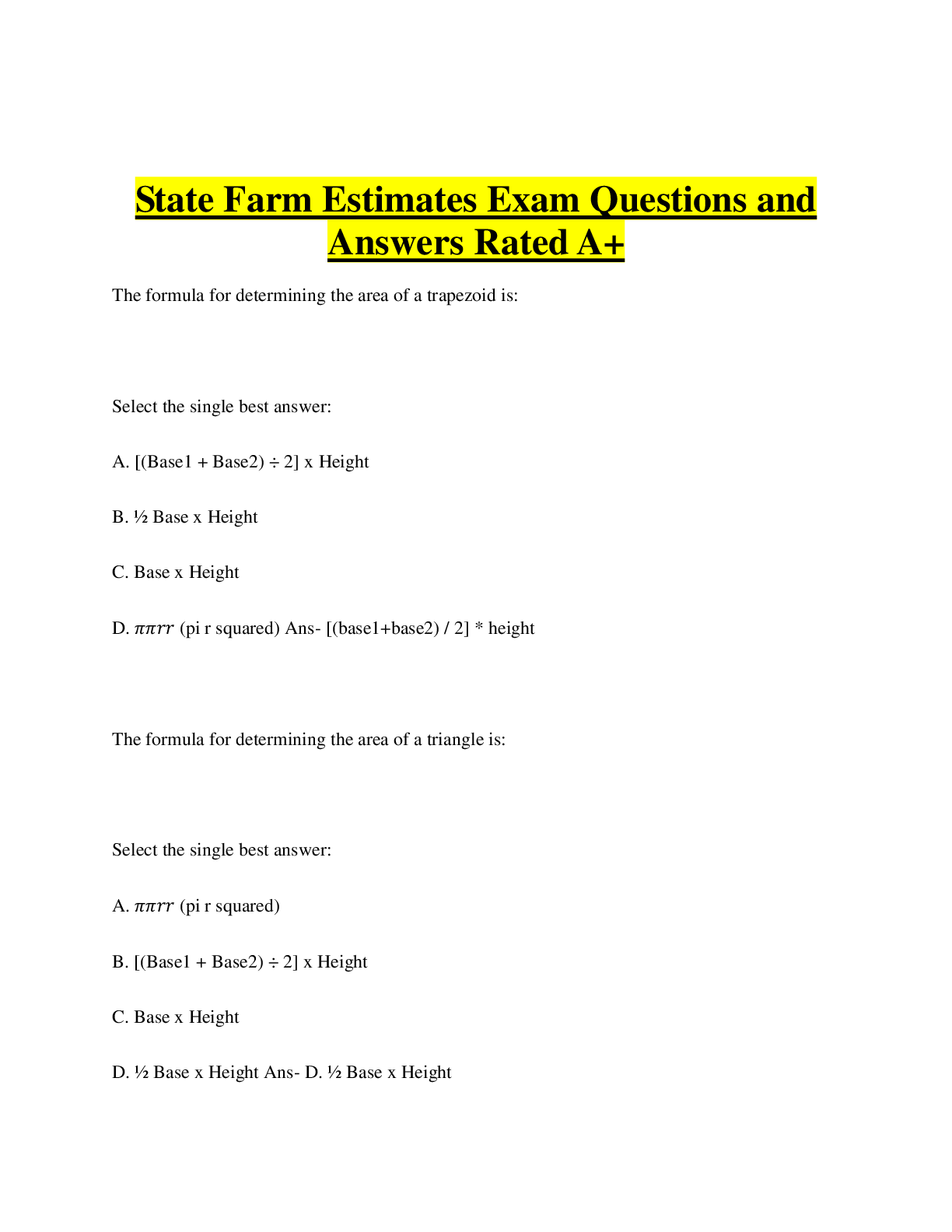

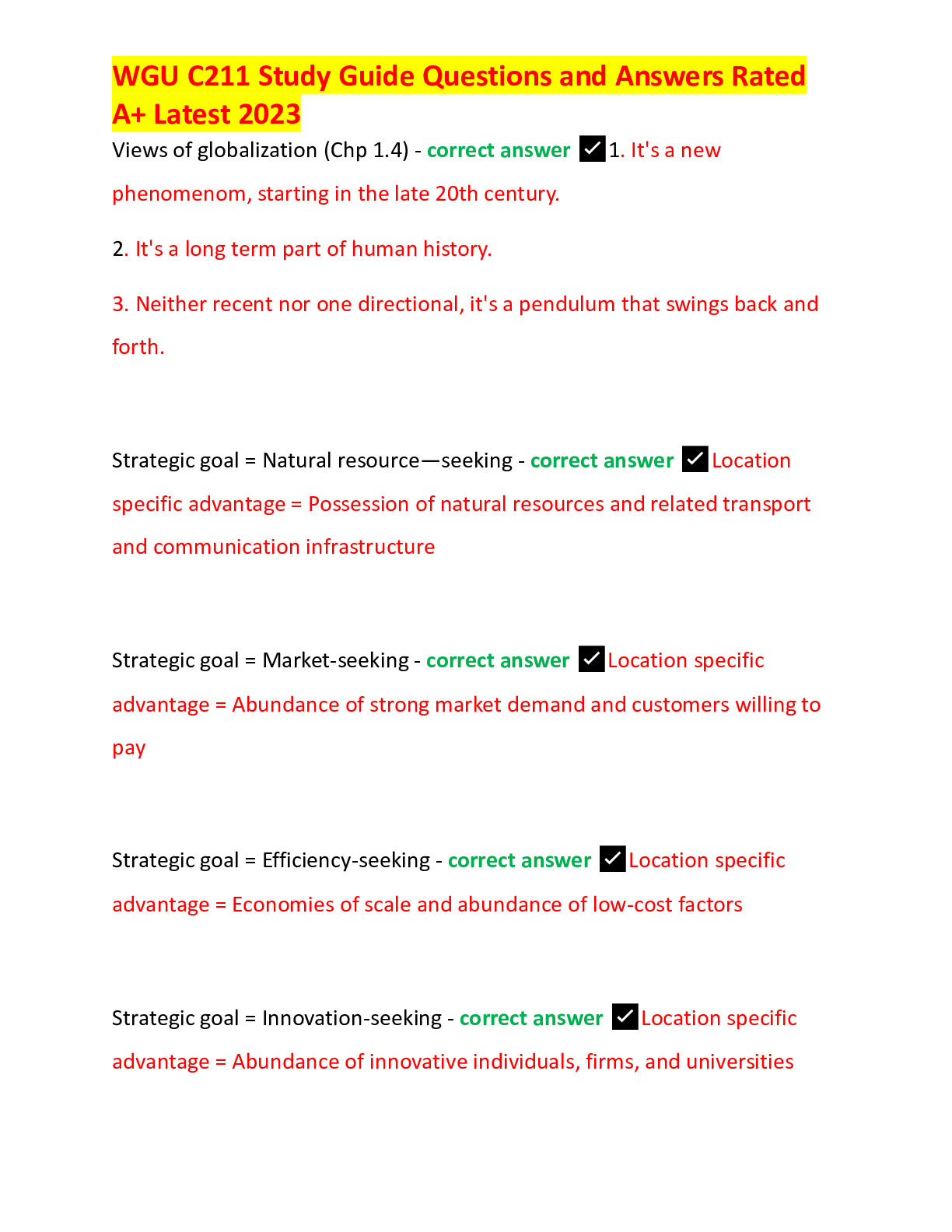
.png)

.png)
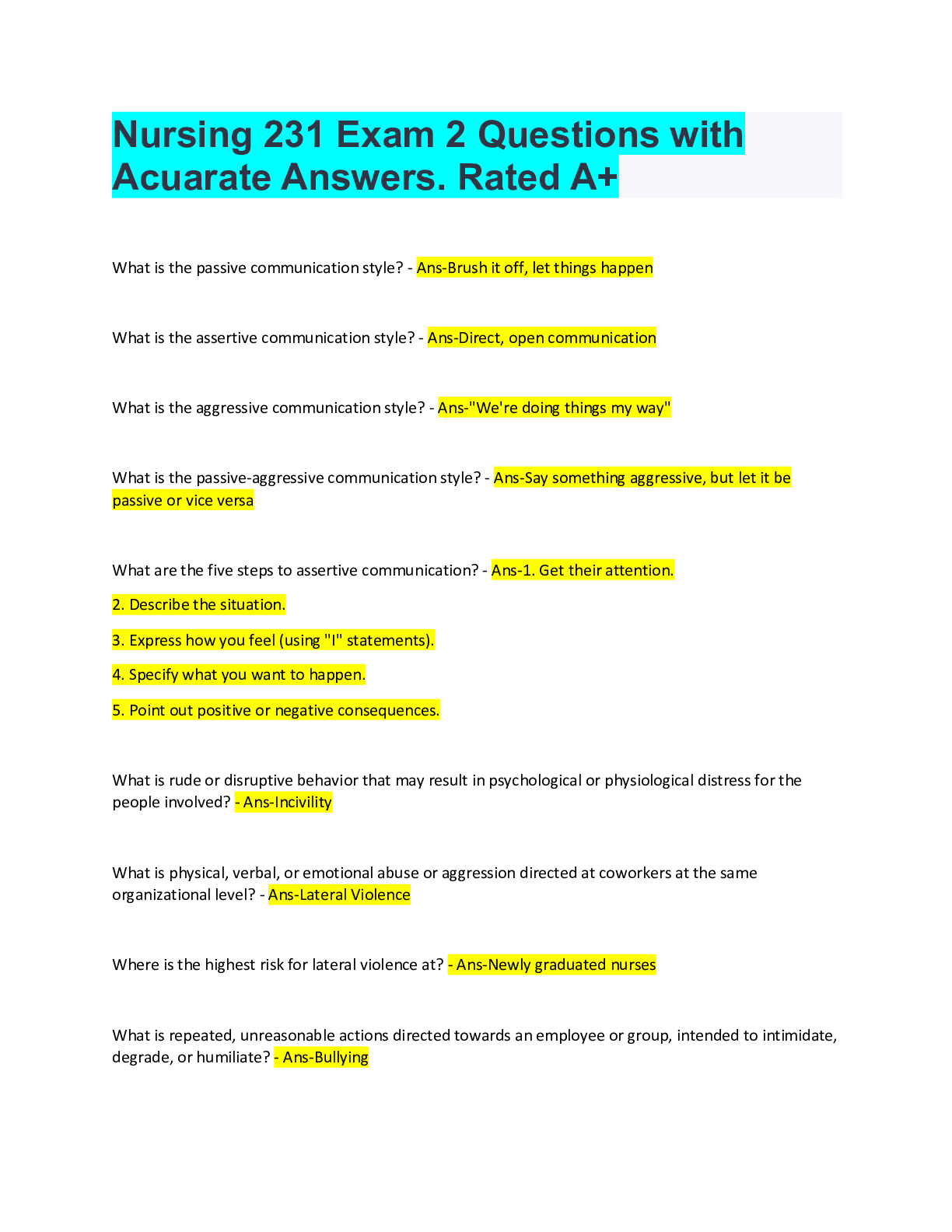

.png)

